
Marcus Hanke
[PuristSPro Moderator]
11515

Comparison review: Tissot Seastar 1000 vs. Seiko 5
Comparison review: Seiko 5 Sports and Tissot Seastar 1000
by Marcus Hanke
by Marcus Hanke
The Seiko 5 is the cheapest sports watch classic with mechanical movement, while the Seastar 1000 is the most recent version a traditional sports watch series by the Swiss manufacturer Tissot. It is also among the cheapest automatic diving watches from a major Swiss brand. Here is a comparison review, which one is better?
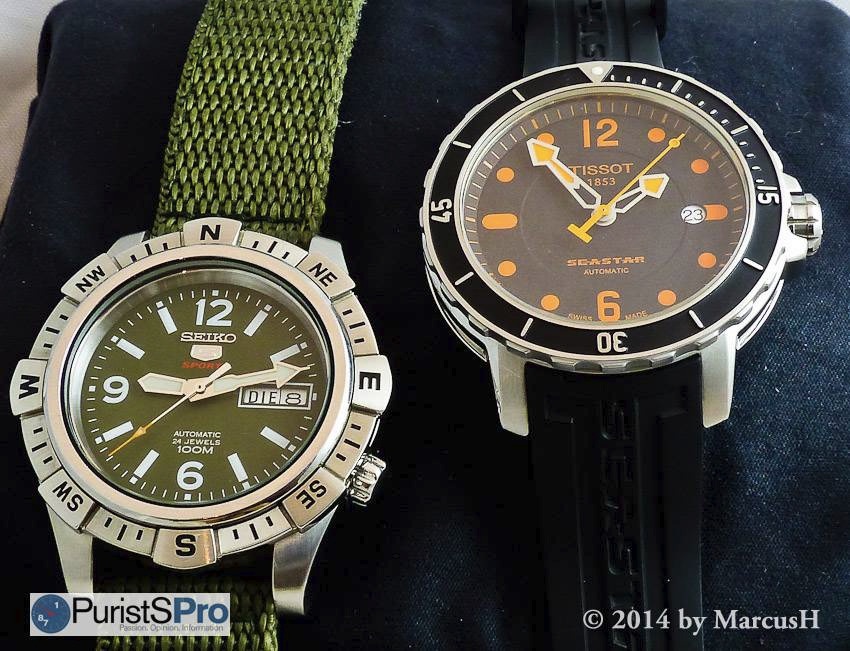
While spring is not really here yet - at least in most parts of the Northern hemisphere - , summer is waiting around the corner, and like every year, many watch enthusiasts will ask the same question: Which watch for vacation, or outdoor activities?
In my previous vacation watch reviews, the timepieces were selected following various criteria, but the price was rarely one of them. This time, I decided to choose the most inexpensive automatic watches manufactured by well-known and traditional brands from Asia, better: Japan, and Switzerland and to review them side-by-side.
The common criteria both had to meet were: solid construction, with a water tightness rating of at least 100 meters; good legibility with sufficient contrast of hands and dial, also with luminous elements; date display. Finally, since they are summertime watches, spots of colour other than black and white were desired.
The two contenders were found rather quickly:
Japan is sending a true classic into the competition: the Seiko 5. Born more than 50 years ago, in 1963, the Seiko 5 was always meant to be a robust, reliable and inexpensive sports watch. The “5” in its series designations stands for:
* automatic movement
* watertight (30 meters minimum)
* shock resistant
* solid steel case
* date and weekday display
Since then, the Seiko 5 became the best selling automatic watch series in the history of horology. The movements used were constantly modernised, and there were - and are - countless different models and styles available. Yet still the price is not only competitive, but constantly held below the competition. The only sacrifice necessary to achieve this was the relocation of the Seiko 5 production from Japan to China.
Here in Austria, the Seiko 5 list prices start at 250 Euros, up to 290 EUR. However, it is difficult to find them at the dealers, since most local Seiko dealers concentrate on multi-functional quartz or spring drive timepieces, rather than considering Seiko’s mechanical lines. As a consequence, Seiko friends are often forced to search for alternative distribution channels, with the convenient side effect of even lower prices.
The Seiko 5 model I opted for is ref. SRP145K1, an attractive and unusual military style watch with green dial, compass bezel and a matching green textile strap. Since the models are changing very quickly in the series, it might be discontinued already at the time of writing this.

For the Swiss bench, it was not that easy to find a good contender: There are many brands selling Swiss watches, but the vast majority in the low price segment are offers produced by private label manufacturers, with only the brand names printed onto the dial. I wanted something more original, and for this I had to look at the offerings of the more traditional, well-known brands.
Fortunately, the huge Swatch Group unites a manifold of brands under its roof, covering practically all price ranges. The first impulse was to look at Swatch, the natural choice when searching a cheap Swiss-made watch. However, when searching for a matching competitor for the Seiko 5, things are not so easy. Steel cases can be found in the Irony series only, and automatic three-hand movements are used only in small watches with a diameter of around 37mm, none of them being really good to read under varying lighting conditions. At around the same price of the Seiko 5, Swatch offers already automatic chronographs in the Irony line. However, I wanted to be the watches comparable, so I decided to skip Swatch, and to look further in the group’s cosmos.
Successful I was when turning towards Tissot. Tissot is an old brand, and always good when searching a rather inexpensive watch with high quality, and - also important - a unique design that is not a simple knock-off. My choice finally fell on the Tissot Seastar 1000.

Tradition-wise, the Tissot Seastar can well be compared with the Seiko 5, since it was also originally launched as a series in the 1960s, when Seastar became Tissot’s designation for watertight watches with special focus on cases and gaskets. Since then, the line has seen many iterations, and is a popular collection subject for vintage watch lovers.
The current Seastar 1000, launched in 2011, is offered in a choice of several colours, and since I wanted something colourful, I acquired the version with black dial and bright orange luminous hands and markers. At first I was undecided between that and a Seastar with bright blue dial and bezel, which was also presented by the dealer. However, I had enough blue watches already, and currently like the contrast of black and orange. The Seastar 1000 is sold in Austria at a list price of about 650 Euros with rubber strap, some 30 Euros more for the bracelet version, which is about two and a half as much as the Seiko 5. This review tries to figure out if the Swiss Tissot is that much better than the Seiko to justify the price difference.
1. Case, crystal and crown
The dimensions of both watches are very similar: The Seiko 5 has a case diameter of 41mm, or 43mm, if measured including the compass bezel, which is protruding over the case a bit. The Tissot Seastar is 42mm wide. Both watches are equally high at 13mm, and are nearly equally heavy, with 90 grams for the Seiko and 95 grams for the Tissot. An important difference lies in the distance of the lugs: Seiko offers a wide array of strap replacement possibilities with its standard 20mm lug distance, while the uneven 19mm of the Tissot make it difficult to find third party straps.
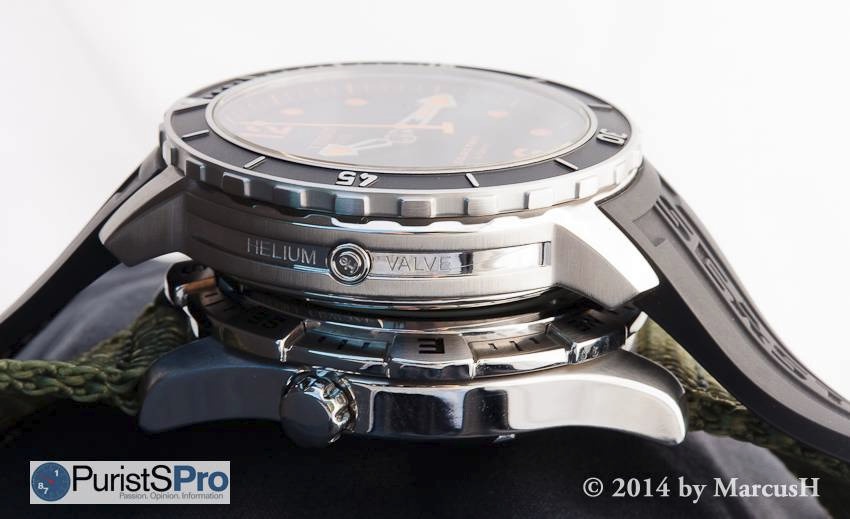
That the Tissot appears to be much larger at first glimpse, is due to the dial, which is considerably larger, with 20% more area than that of the Seiko, and the black coated diving bezel, which optically extends the black dial. Both watches appear very balanced in proportions, I especially like that for true sports watches, they are really thin on the wrist.
Differences become apparent upon closer inspection: the Seiko’s steel case is polished with the only variations in surface treatment being the upper surface of the lugs, which are slightly brushed. Other than that, there are no facets, geometric protrusions, chamfers or any other design features on the case. The edges are not sharp, but appear rounded, a result of the simple tumble polishing process.

In direct comparison, the Tissot’s case is very different, and much more ornamental: While the basic surface structure is brushed in different directions for lug surfaces and case sides, there are highly polished facets along the upper edges of lugs and case. Additionally, the case sides feature unique polished recesses.
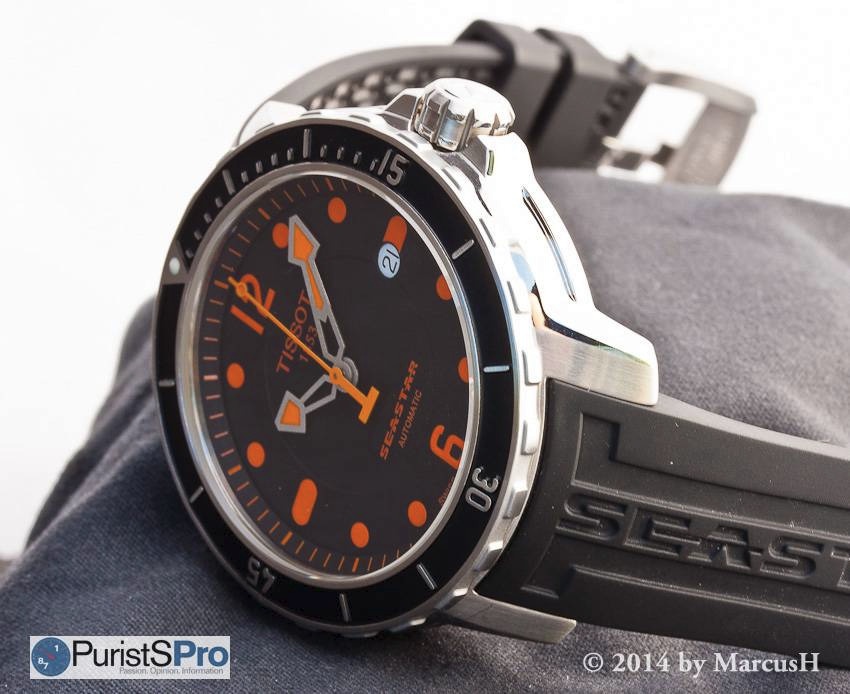
The Seastar protects its crown by means of crown guards, while the Seiko does not need such a feature: Its crown is relocated to the less exposed position at 4, and also slightly recessed into the case, which should protect its stem against direct hits equally well.

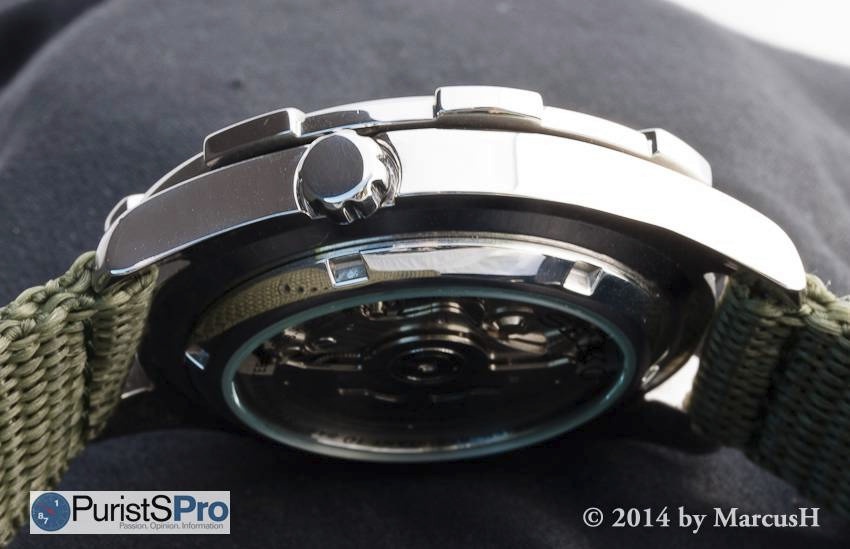
However, there are also some technical differences: On the Tissot’s left side, I am astonished to find a technical feature that 99.9 periodic percent of watch owners will never need in their lives: a helium valve, that is useful only for professional divers using a diving bell for extended time.

Much more important is the difference in the water tightness ratings: While the Seiko’s 100 meters is fully adequate for all everyday challenges, also when swimming, the Tissot offers 300 meters and is therefore a genuine diving watch. This higher pressure resistance is surprising, given the similar case dimensions and the displayback and proves that some effort has gone into the case design and the gaskets.
The two revolving bezels are also different, due to their different purposes: The Seastar has a classic diving bezel, rotating counter-clockwise only, with 60 smooth, but well-defined clicks. It could be a bit better to grip. Not common in its price class is the bezel finish: markers and numbers are raised, while the recessed base is galvanically coated with black colour. The triangular marker at 12 contains a bright luminous dot.

The Seiko’s compass bezel matches the watch’s outdoor, resp. military character. It can be turned smoothly into both directions, with no clicks at all. Due to the protrusions at the main and intermediate compass points, it offers a very good grip. the practical use of such a feature, however, is very limited, if not inexistent. Maybe it is some kind of memory aid when hiking, after a compass reading has given a definite course to move along. The “N” can serve as a marker to measure elapsed times, as a makeshift chronograph function. But in this function, the high-contrast diving bezel of the Tissot is better. Anyway, the compass bezel looks cool, and it is also well executed, since all markings are engraved and filled with black, and not simply printed.

Overall, the Tissot case offers not only more optical refinement to the spectator, but with the higher pressure resistance and the helium valve also some technical advantages, reflecting a higher productive effort. If this is needed, is a different question that can be answered only by the owner.
The gap between the two watches is further widened when checking the crystals: the Seiko 5 series traditionally uses a specially hardened mineral crystal, called Hardlex. It is softer than the sapphire crystal the Tissot is equipped with, and therefore more prone to collect scratches. The larger diameter of the Tissot crystal additionally increases the production cost. Neither of the crystals features any anti-reflective coating which is not a problem, due to their flatness.
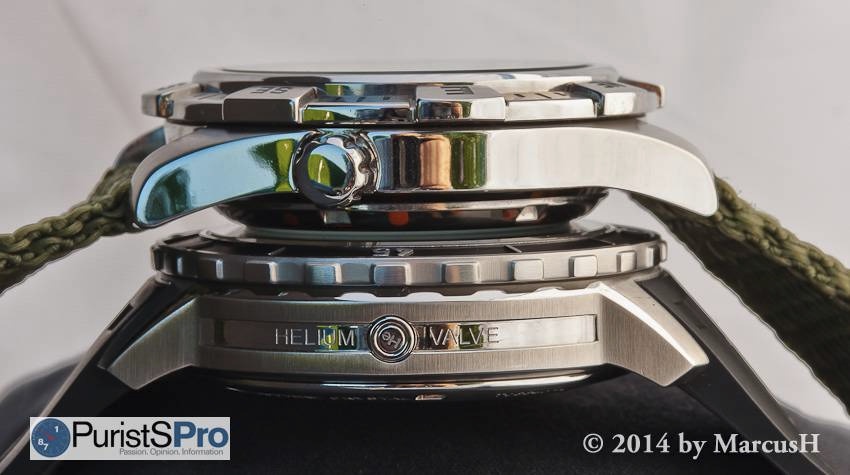
Both watches have displaybacks with full threads, sapphire on the Tissot, Hardlex mineral crystal on the Seiko.
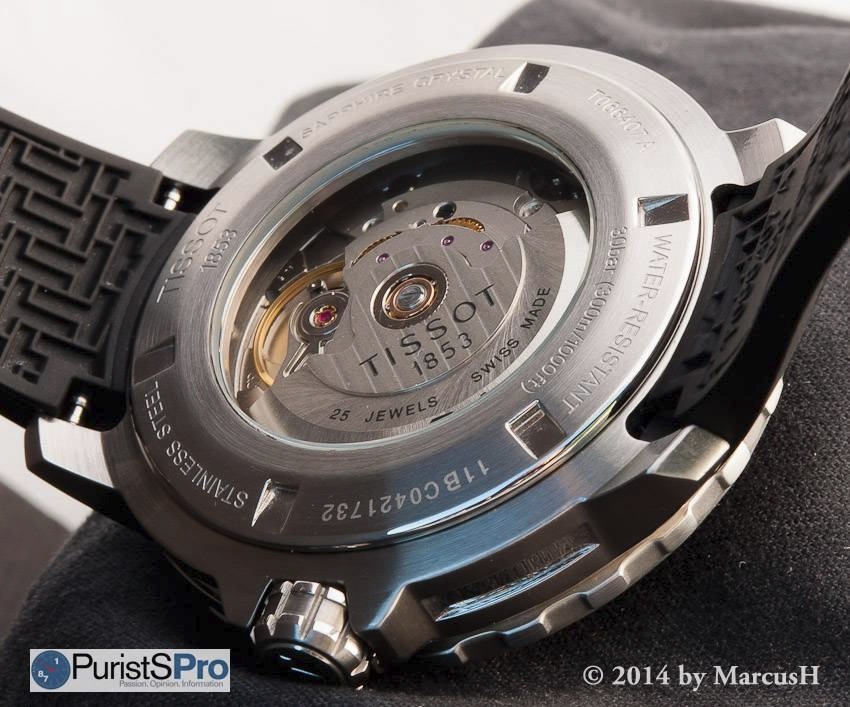
As can be expected from a diving watch, the Tissot’s crown is screwed down, while on the Seiko, it is not. This is okay for an allrounder timepiece. While the former is much more elaborate in design, with a big T on top, easy to grip and operate, the Seiko crown is pretty standard and featureless, but also easy to use.

2. Dial and Hands
Both dials are similar in character: With bold luminous markers and a few numerals, they offer good contrast, at least in daylight. In darkness, the Seiko’s own patented Lumibrite substance offers a luminous performance similar to the well-known SuperLuminova C3. The Tissot uses SuperLuminova with orange tint, which is far less effective. For the desired spots of summer colour, the Seiko dial has a beautiful green tone, while the Tissot’s impresses by its bright orange markers. Both dials are remarkably well executed, especially when considering the watches’ low price, and even more so when considering the dials I have been confronted with lately in much, much more expensive timepieces. All prints are crisp and without bleeding or other flaws, and no dust particles are visible on the dial surfaces.
Small details reveal the higher production effort invested into the Seastar dial: Its center is recessed, the minute markers are printed onto a black galvanised rehaut ring, while the completely flat Seiko dial is held in place by a naked metal ring. On the other hand, the Seiko 5 logo is made from well applied metal parts, and the Asian watch’s specialty, the weekday indication aside the date, adds a great plus in usability. Especially nice is the colour-coding of the weekdays: Saturday is printed in blue, Sunday in red, so the weekend gets a fresh spot of colour.
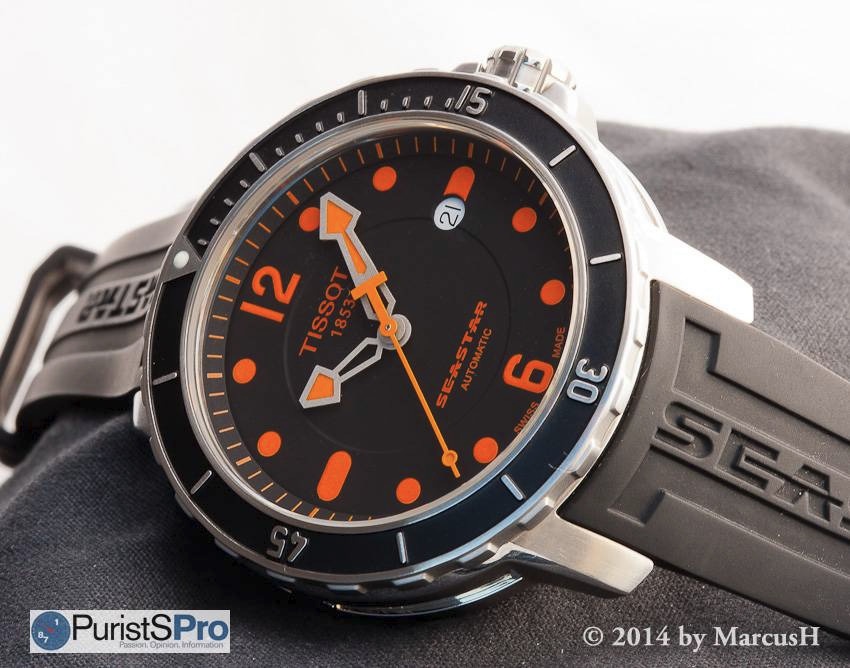
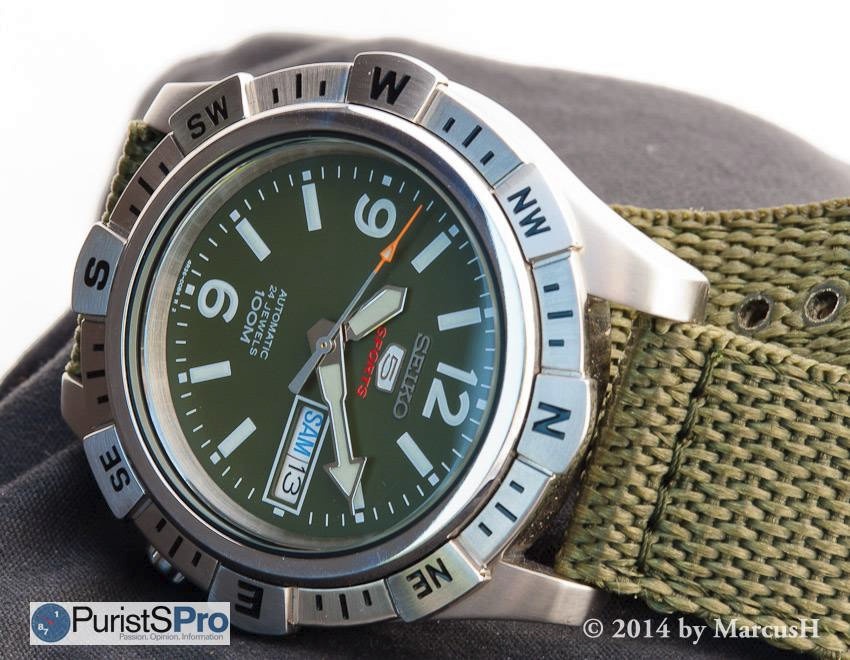
The circular date window of the Tissot is the result of a nice design effort: it completes the rounded marker at 3. In order to fit into this window, the figures of the regular ETA date rings would be too large, which is why Tissot uses a specially printed date ring with a font style perfectly matching the dial. While it would have been great if the date ring had an orange base colour, I have to take into account that the black/orange dial version makes out only a small share of the Seastar 1000 production run. All other variants have bright white markers, and here the date window matches perfectly, at a quick view upholding the illusion of unharmed markers and no date window at all. That Tissot is able to produce specific date rings for its inexpensive watches, makes it the more depressing that brands charging ten or twenty times that much for their products appear unable to show similar care for their design coherence.
Speaking of design: Another argument for the two watches tested is that both do not use hand designs seen a million times elsewhere already: Seiko has polished steel hands, where the minute hand is shaped like an arrow; not only an arrowhead, which is very common indeed, but like a complete arrow, with the feathered tail. A pointed tip improves the accurate reading.
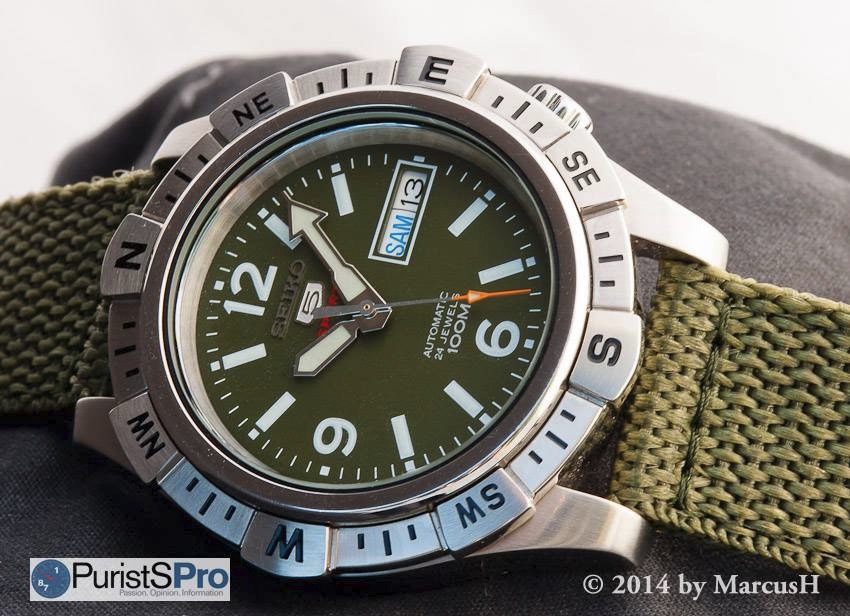
The Tissot Seastar 1000 hands remind me of an unconventional style I have seen on a vintage timepiece lately: I believe these hands were called “snake head”, but I am not certain about it. Anyway, the Tissot hands are unusual and unique not only due to their outlines, but also to their frosted metal finish, which greatly enhances their visibility. The finish makes the metal framework appear white above the black dial, together with the orange SuperLuminova, they are immediately and clearly legible even at a very quick glimpse.

Both second hands have small luminous elements as well, the Seiko has an orange painted tip, while the Seastar has a fully orange coloured second hand, with the Tissot-T as a counterweight at the rear end.
Once again, the level of execution of these parts on both watches lets me wonder about the reasons why so many, very expensive watches have quality problems, especially noticeable on the hands. The complete lack of paint noses, spray and similar flaws on the Tissot’s coloured second hand suggests it has been cut from a pre-coloured metal sheet, while the Seiko hand’s tip has been painted later, but also without any flaws. Its unpainted metal part shows some minor scratches, though, visible only under high magnification. It is time that the watch part suppliers adopt this good standard as a common one for their complete production.



3. Strap and buckle
Contrary to my expectations, I found the green nylon fabric strap of the Seiko 5 to be of good quality and matching the dial colour. Its holes are strengthened, and the strap’s edges are well stitched, no fibres are sticking out, even after frequent use. The length is also okay even for wide wrists. Two metal clips, similar to those used on NATO straps, hold the unused end of the strap. The tang buckle is strong, but cheaply made, a stamped steel part with bead-blasted finish.


Better in this respect is the Tissot, with a solidly milled steel buckle, faceted and partially polished to match the style of the watch’s lugs, the logo is engraved and black filled. The black rubber strap is very soft and comfortable, the “Seastar” lettering looks nice. Its irregular, T-letter structured back side, however, is very difficult to keep clean: Sand, sweat and water build up residues hard to remove, even with a brush. As already stated above, the 19mm width makes it difficult to find alternatives.


4. Movement
The cheaper Seiko is equipped with a true manufacture movement, while the Tissot’s engine can be called manufacture in a wider sense, since the ETA is part of the Swatch Group as well. For the overall quality, however, it is absolutely without importance whether a movement is made inhouse or not.
For a while, the Seiko 5 was widely considered to be a low quality watch, since its simple automatic movement had no provision to wind the mainspring manually. To start the watch, one had to shake it and then to wear it very actively, until the mainspring built up sufficient tension. Since around 2011, this drawback has been corrected, with the advent of the cal. 4R36A, also used in the watch reviewed. This movement has a hack second and manual winding. Aside that, it features a power reserve of about 40 hours at an oscillation frequency of 21,600 A/h. The rotor is winding the mainspring bi-directionally.
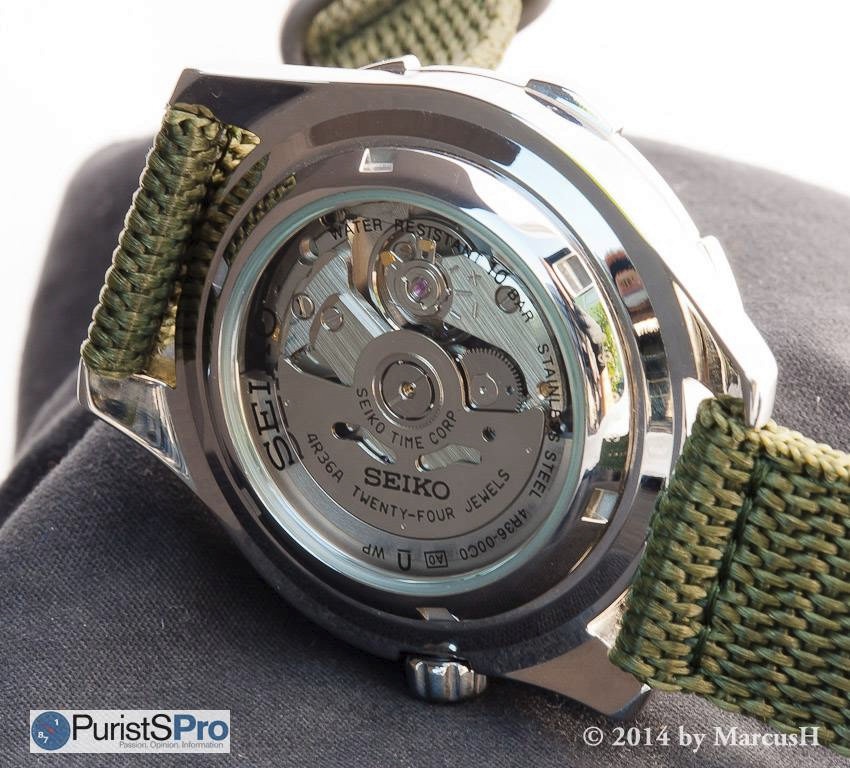
In direct comparison, the Tissot’s ETA cal. 2824-2 is very similar: It is a bit smaller in size (ETA diameter: 25.6mm, Seiko: 27mm, ETA height: 4.6mm, Seiko height: 5.32), has a slightly shorter power reserve (38h vs. 40h), but a higher oscillation frequency of 28,800 A/h. While both movements share the ETAchron regulation system, the regulation of the 2824 might be a bit more sensitive due to the eccentric screw.

Small difference exists regarding the change of the date display: the ETA changes the date instantaneously at midnight, but the Seiko needs more time: One hour, starting at 11 p.m., it lasts to change the date, and another hour, until 1 a.m., until the weekday has switched, too.
Both movements have proven their capabilities in thousands of timepieces and are solid and reliable. Regarding their serviceability, watchmakers in Europe are certainly less familiar with the Seiko 4R36A than with the ubiquitous ETA 2824. However, Seiko does not use any unconventional principles, and I was told that spare parts are readily supplied to watchmakers, so it should not be a problem to service and repair a Seiko 5 anywhere in the world.
Comparing the surface finish of the two movements leaves the Tissot expressing the higher effort to make the movement appear attractive. The Seiko is rough, with scratches on the bridges, screwheads with clear traces of automated assembly, the rotor appears a bit wimpy, with imprints of poor quality.


The ETA is not that much better, the only clear improvement is its rotor, which not only has clean edges and some Geneva stripes, but its inscriptions are engraved and filled, instead of simply surface printed. Nice detail is the Seastar lettering and scuba diver outlines on the rotor rim, showing that this rotor is used by the Seastar series exclusively.


5. Accuracy
The accuracy testing leads to most surprising results: Worn on the wrist 24/7, the cheap Seiko 5 gains an average 6.5 seconds per day, however with quite some daily variation, between +1 and +15 seconds per day. When subjected to the traditional COSC chronometer testing procedure (two days each for every position, while I test in six positions, versus five, as done by the COSC), the cal. 4R36A has no real problems to meet the COSC chronometer criteria. In the positions 12 up and 3 up it loses between 5 and 7 seconds per day, but in all other positions, it shows a stable gain between 2 and 5 seconds.
The standard measuring and adjustment procedure at Seiko for these movements is based on the three positions 6 up, 9 up and dial up, which give the best results for the movement tested. The other three positions perform worse, but still good.
The daily variation in each position is fractional at 1 second. This leads to a daily loss of only 0.33 seconds. Altogether, the Seiko’s performance is an excellent example of how good a mass-produced mechanical movement and its fully automated assembly can be, without any special hand-tweaking.
On the other hand, the Tissot’s cal. 2824-2 demonstrates nicely, why many watchmakers make a difference between a movement’s adjustment and its regulation. Worn on the wrist all day long, the Tissot gains a rather sobering 18 seconds per day. After only three days, the Seastar is off by a minute. Closer inspection, though, reveals that over all days, the maximum deviation from this average 18 seconds is but one second. Making the six positions for two days each-test, further supports my suspicion: This movement is very well adjusted: while the mean daily rate through all positions is a poor 18 seconds, the variation is very small, and the largest difference between the average daily rate and the singular daily readings is only 5 seconds, half of what the chronometer norm would accept.
What should be improved is the regulation. Based on the measured rates, all the watchmaker has to do is to reduce the gain a bit, and he would not have to care about the different positions. Then the Tissot Seastar, too, should have no problem to be well within the official chronometer limits.
6. Ergonomics
Wearing the watches is pure pleasure: They are light, not oversized, but still large enough to offer a good legibility and to leave a nice impression, have no sharp and hurting edges or protrusions. Their straps are comfortable and long enough even for wide wrists, the simple tang buckle permits a quick fine-adjustment of the length.
Dial contrast and legibility of the hands is excellent in both cases, at least during daylight. In darkness, the clear winner is the Seiko, but only because I deliberately opted for the orange hands and markers on the Seastar, fully aware of the fact that any colour tint drastically reduces the efficiency of luminous pigments. No colour on the markers would have led to a more balanced result.
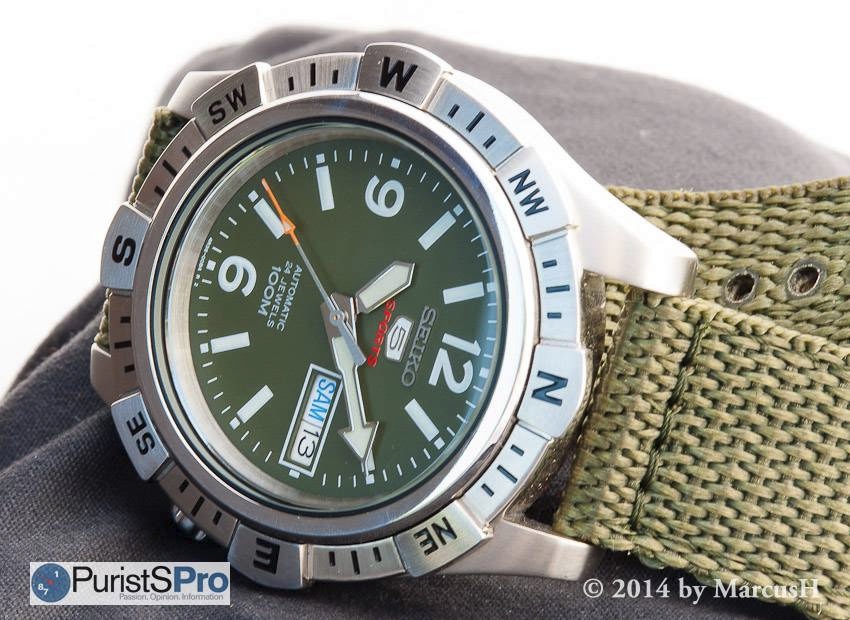
For me personally, the Seiko has a big advantage for its clever weekday indication and its well legible date numerals. There is another issue: All Seiko 5s have bilingual weekday rings, their imprints depending on the markets the watches are sold in. In my case, the languages offered are English and German. That Seiko, with its limited sales of mechanical timepieces in German-speaking countries, nonetheless offers German calendar indications, is a slap in the face of all the ultra-exclusive Swiss watch manufacturers who claim that such lingual adaptions would cost too much - for watches sold at tens of thousands Euros. It appears that we, the customers, are far too tolerant.
7. Final Verdict:
Is there a clear winner in this comparison? As so often in life, the answer must be: it depends on the circumstances.
The Seiko 5 is all the watch you need - point. It is a wonderful and reliable companion in everyday life, or simply during the vacation. It is cheap enough to become the subject of a whole collection, with a Seiko 5 for every mood, for every opportunity.
Sometimes, however, satisfying the bare necessities is not enough. Once the taste has been successfully spoilt, we increasingly care for the small details that are making the difference. We want more, more refinement, more style, more food for the eyes. And here, the Seiko cannot beat the Tissot It has just a bit “more” in every detail: more design details on the case, more finish details on the movement, more feeling to the bezel, more design on the dial.
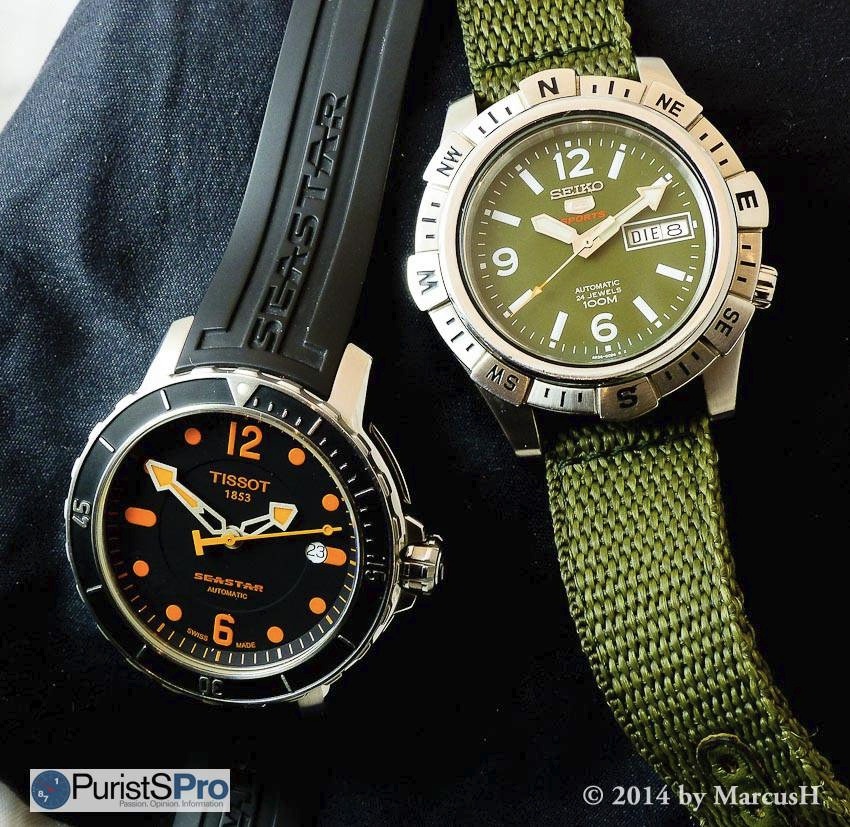
If one desires this amount of “more”, one has also to spend more, this is the rule. In my opinion, the price difference between the Seiko 5 and the Tissot Seastar 1000 is justified, not only because of the sapphire crystal, but because of the overall perceived value, which is higher on the Tissot - because of the many details. This does not devalue the Seiko 5, in the contrary. In all respects it proofs what is possible, if a traditional manufacturer gets involved with the goal to offer a maximum of technical quality at a minimum of price.
And the Tissot should be a challenge to the rest of the industry, because it will be difficult to find other watches with equally good technical features and original design at a similar price. And even a two and a half-fold price will barely offer a watch with that much more of “more”.
Copyright March 2014 - Marcus Hanke & PuristSPro.com - all rights reserved

Comparison review: Tissot Seastar 1000 vs. Seiko 5
Comparison review: Seiko 5 Sports and Tissot Seastar 1000 by Marcus Hanke The Seiko 5 is the cheapest sports watch classic with mechanical movement, while the Seastar 1000 is the most recent version a traditional sports watch series by the Swiss manufactu...
